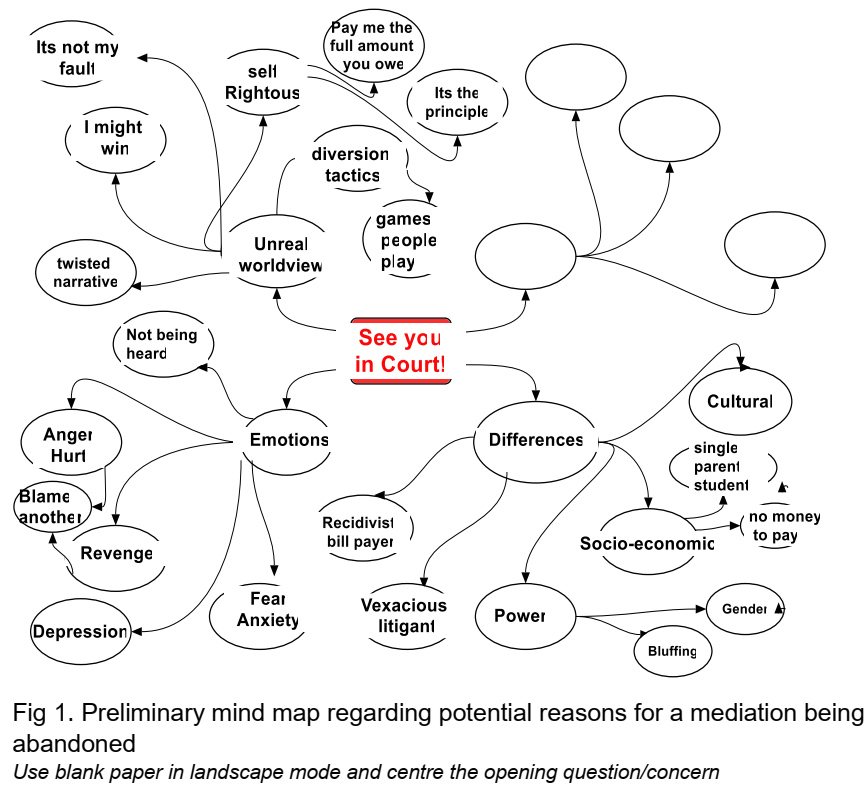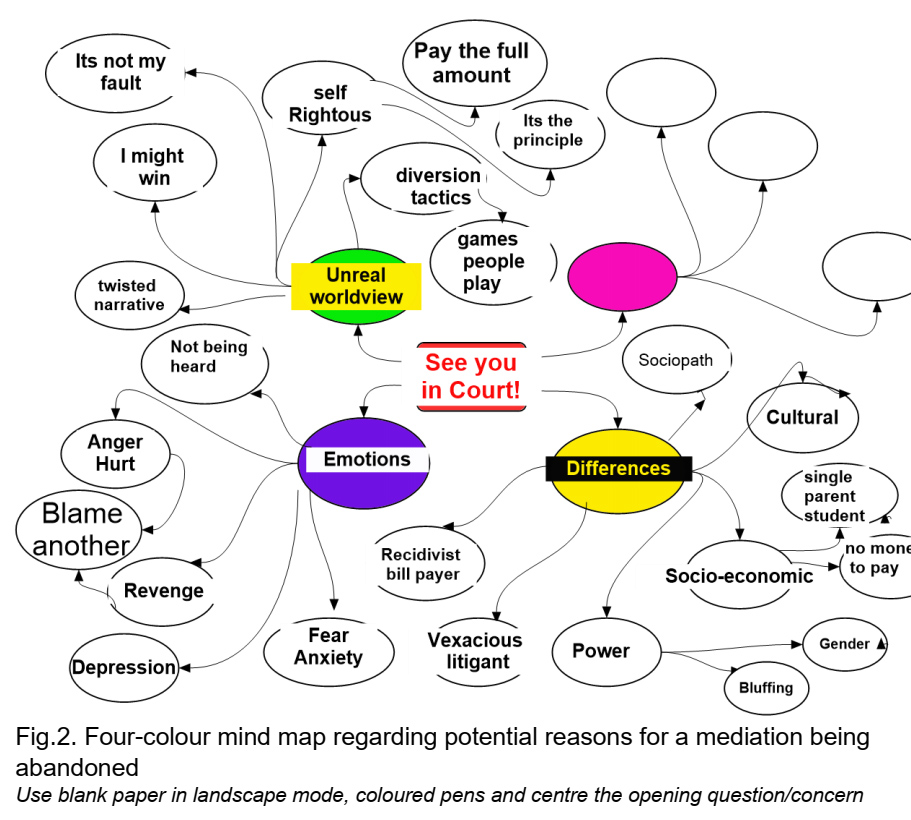mind maps for mediators
- David Mitchell

- Aug 18, 2022
- 5 min read
David Mitchell
Reflective Practice fits with the learning needs, professionalism and outcomes of mediators. It helps deal with rapid changes, unexpected events, disorder, mis-assumptions, challenging emotions and situations and the professional isolation of many mediators, especially those working as solo practitioners. [1]
Remembering, revisiting, recollecting a journey through the pre-mediation encounters (reflection-before) and through a mediation (reflection-in) can form the thought bubbles that connect or diverge into separate themes (reflection-after). This forms a powerful learning experience.
Mind Maps
An easy to learn, adaptable reflection process involves using mind maps. They are invaluable to a mediator as reflection, especially after a pre-conference, and post-mediation. Since mind maps incorporate both a learning component and a memory storage facility, the mind map can be instantly recalled and ‘read’ internally at any time during a mediation.
Our minds process and store information as maps via the hippocampus. A mind map starts off as a piece of blank paper in landscape orientation and a collection of coloured pens/pencils. A thought, idea, question or problem (usually 1-3 words in capitals) is written, in colour, inside a balloon, rectangle or doodle. Radiating out from the centre, and linked by a ‘road’ or arrow, are entered (in different colours) the main points that ‘spring to mind’. In turn more and more links or roads to the sub points are added, See Fig.1. The mind tracks the movement of the head, the eyes and the hand holding the pen; the colour and the word(s) that are inscribed on the page; the links (roads) that make connections with other word-thoughts; and stores this information as a map.
Buzan , the developer of mind mapping promoted his 10 ‘golden’ rules for mind-mapping[2] :
1.Place an image or topic in the centre using at least 3 colours 2. Use images, symbols, codes, and dimensions throughout your Mind Map. 3. Select key words and print using upper or lower case letters. 4. Each word/image is alone and sitting on its own line. 5. Connect the lines starting from the central image. The central lines are thicker, organic and flowing, becoming thinner as they radiate out from the centre. 6. Make the lines the same length as the word/image. 7. Use colours—your own code—throughout the Mind Map. 8. Develop your own personal style of Mind Mapping. 9. Use emphasis and show associations in your Mind Map. 10. Keep the Mind Map clear by using radial hierarchy, numerical order or outlines to embrace your branches. (Metiver provides a good explanation of Buzan’s model without having to buy a book.)
An 11th rule is to sound the word(s) as they are written (see below under hippocampus)
These rules are not absolute, so, an individual can create their own style of words, circles and boxes and colour schemes. Perhaps a single pen and one colour is enough (See Fig.1). For others 3-5 colours work. Some Buzan trainers/demonstrators will use up to 24 different coloured pens. However, taking the “See you in Court” map 3-4 colours could suffice: (see Fig.2).
Fig.1 is a demonstration of a mind map reflecting on the things that can go wrong within a mediation that can cause the mediation to be abandoned. Spare ‘balloons’ have been inserted to add further thoughts/memories.
· This map can be recalled from memory at any time (provided it has been stored in long term memory, see below) and, within a mediation, can be a warning call for a mediator to change direction, tactics, approaches or communication.
· This map can be extended to add in a mediator’s possible solutions, changes or tactics, that can be recalled at a moment’s notice, within a mediation, and possibly travel down a different road towards resolution.
Fig.2. 4 colour mind map re potential reasons for a mediation being abandoned Use blank paper in landscape mode, coloured pens and centre the opening question/concern
This form of mind-mapping is called learning by “association ” and is a very efficient memory storage mechanism. Research had found that a human can only process 4-7 items at any one time (think multitasking 4-7 things at once). By creating a mind map of multiple associated (logically connected knowledge, thoughts, ideas, beliefs, etc.) this cluster becomes one unit or item (not 10 or 20 or 30 separate items) available from short term or long term memory, at an instant’s notice. Perfect for a mediator deliberating or reflecting- in-action within a mediation.
Morewedge & Kahneman concur with this processing : “activation spreading selectively within associative memory generates and continuously maintains a rich, coherent and mostly accurate representation of the current state of affairs, with links both to the past and to the likely future and supports a readiness to act and react appropriately.”[3]
The Hippocampus Connection The hippocampus and neo-cortex respond to interest, emotions, visual inputs (e.g. colour, symbols, pictures, faces and maps) and aural/sound inputs [4]. The greater the interest, curiosity or need to learn and the greater any association or mapping concepts the more the collected pieces of information are bundled together by the hippocampus and stored as an item for recall from short-term then, later, long term memory.
The Hippocampus and surrounding areas of the brain, have highly specialised place cells, grid cells, concept cells[5] and position-motion-direction cells[6],[7] that receive, collate and process signals from
· Space/orientation of self and the surroundings: “I am in a room, sitting, drawing”.
· Objects: visual inputs: surroundings, a picture or graphic or map or representation: “ I see a page containing squiggles, arrows, circles-squares-rectangles that are interconnected.” “Inside these objects I see letters and words”
· Colour: “I see clusters of different colours”
· Sounds: “I hear me sounding words”
· Time: I am making this map of associations at …am/pm.”
· Emotions: I and/or mediatees emotions interfered by …..”
· Corrections, insertions and deletions: ”I am adding/subtracting/ changing the picture-map”.
· Context: “I am creating a mind map of a mediation issue”
· Memory :” I am storing this concept in ‘working memory’(short term memory) to help me make a decision or an analysis of a current concept. I can choose to upgrade it to long term memory”
The aim is to convert the map into long term, easily recalled memory, There are three components that achieve this Repetition: repeatedly firing (recalling) a neural pattern indicates its importance and deepens the memory; Association with another memory or concept, the stronger the better (an extremely powerful memory/learning strategy); Emotional state, the greater the emotional arousal, the stronger and deeper the memory .” Conclusion with Reflections on my (i.e. the reader’s) mind map
The challenge is to ‘write then read the mind map’ and ponder:
From my experience, what can I add to this map (hence the blank ovals the author has left in Figs1&2);
What can I add to my knowledge bank/repertoire for my next mediations;
Where could I have changed direction and how (Head-banging is not an option!)
What stories can I add, what tacit knowledge can I share with other mediators?
Enjoy your journey!
[1] Rochelle Arms Almengor,. 2018. Reflective practice and mediator learning: A current review. Conflict Resolution Quarterly. 2018;36:21–38. Quoted in David Mitchell, Reflection and Reflective Practice, 2020, Pulse ezine, available from
https://memberconnect.resolution.institute/HigherLogic/System/DownloadDocumentFile.ashx?DocumentFileKey=6f50a868-21d8-b07d-d781-10f63cde1744&forceDialog=0
[2] Anthony Metiver 2021 Mind Map Mastery: 10 Tony Buzan Mind Mapping Laws You Should Follow. Downloaded from https://www.magneticmemorymethod.com/tony-buzan-mind-map-mastery
(Metiver provides a good explanation of Buzan’s model without having to buy a book.)
[3] Carey K. Morewedge & Daniel Kahneman. Associative Processes in Intuitive Judgment . Cogn Sci. 2010 October ; 14(10): 435–440. doi:10.1016/j.tics.2010.07.004.
[4] Christopher S. Keene, John Bladon, Sam McKenzie, Cindy D. Liu, Joseph O'Keefe, Howard Eichenbaum 2016.
Complementary Functional Organization of Neuronal Activity Patterns in the Perirhinal, Lateral Entorhinal, and Medial Entorhinal Cortices Journal of Neuroscience 30 March 2016, 36 (13) 3660-3675; DOI: 10.1523/JNEUROSCI.4368-15.2016.
5 Michael E. Hasselmo, Mark P. Brandon, "Linking Cellular Mechanisms to Behavior: Entorhinal Persistent Spiking and Membrane Potential Oscillations May Underlie Path Integration, Grid Cell Firing, and Episodic Memory", Neural Plasticity, vol. 2008, Article ID 658323, 12 pages, 2008. https://doi.org/10.1155/2008/658323.
6 Emily Singer. Brain’s Positioning System Linked to Memory. Downloaded 10/05/2021 from https://www.quantamagazine.org/brains-positioning-system-linked-to-memory-20141007/
1038/s41467-019-13760-8 ttps://doi.org/10.1038/s41467-019-13760-8 https://doi.org/10.1038/s41467-019-13760-8 https://doi.org/10.1038/s41467-019-13760-8 https://doi.org/10.1038/s41467-019-13760-8 https://doi.org/10.1038/s41467-019-13760-8










Comments